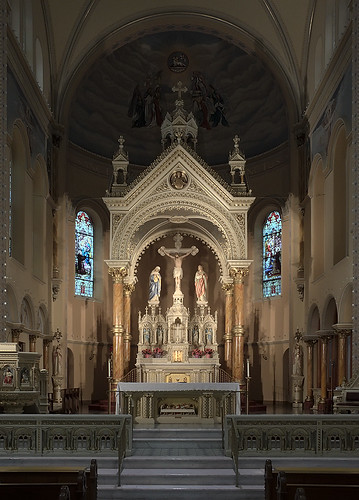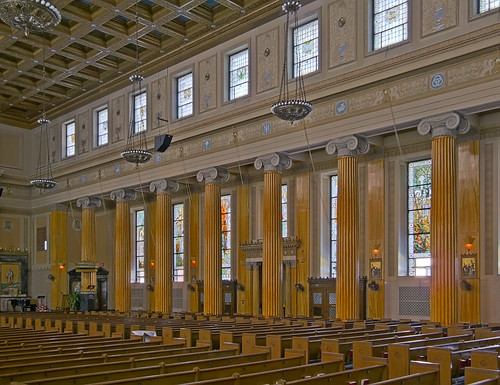
Confessionals at the chapel of Kenrick-Glennon Seminary, in Shrewsbury, Missouri. Designed by Duncan G. Stroik, of South Bend, Indiana.
Click image for larger versions.

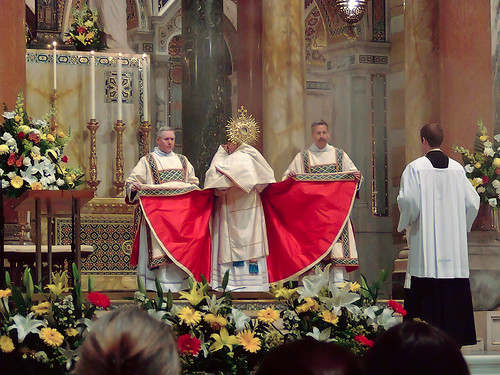
1909 Finally, the common good requires peace, that is, the stability and security of a just order. It presupposes that authority should ensure by morally acceptable means the security of society and its members. It is the basis of the right to legitimate personal and collective defense.
2239 It is the duty of citizens to contribute along with the civil authorities to the good of society in a spirit of truth, justice, solidarity, and freedom. The love and service of one's country follow from the duty of gratitude and belong to the order of charity. Submission to legitimate authorities and service of the common good require citizens to fulfill their roles in the life of the political community.
2310 ...Those who are sworn to serve their country in the armed forces are servants of the security and freedom of nations. If they carry out their duty honorably, they truly contribute to the common good of the nation and the maintenance of peace.
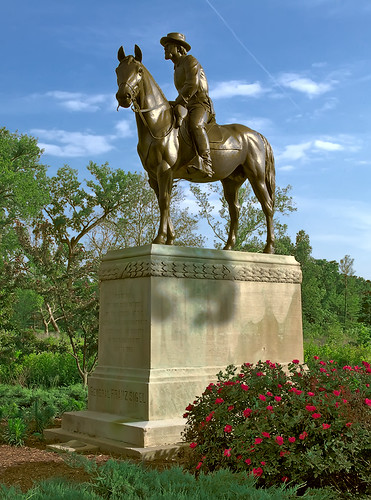
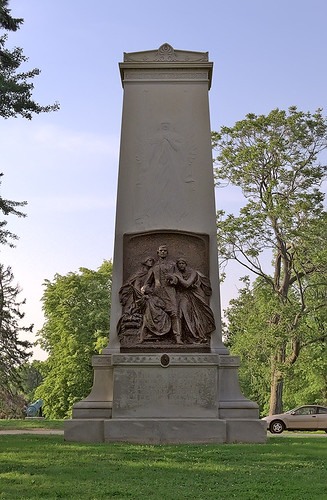
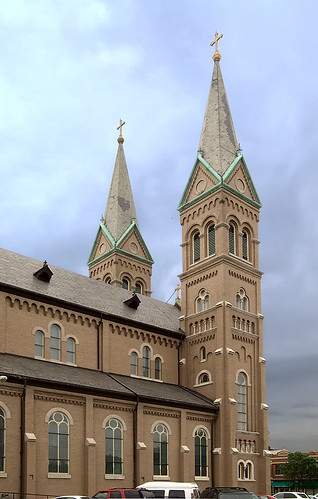
St. Anthony's conforms the best laws of ecclesiastical art by combining many beautiful details into a harmonious pattern. It creates the impression of massiveness when viewed from the exterior. Two square, well-proportioned Romanesque towers add to this impression. Inside, however, the church's massiveness seems to melt away by interior of light and color, for a general result of warmth, beauty, and grandeur. Its harmonious pattern will become more apparent as the single murals and windows are viewed in the ideas the designers had in mind.
The architectural style of the church is Romanesque, borrowed from some representative copy of this architecture in the German Rhineland. Romanesque style's chief characteristic traits are the rounded arch, the floor plan in the form of a cross and rounded vaulted ceilings, with the circle and curved line prevailing throughout.
St. Anthony's was erected in 1910 at a cost of $175,000 — unbelievable at today's building costs. And it was completely paid for by 1919. In fact, on Thanksgiving Day in 1919, the church was consecrated. (Only a church that is completely paid for may be consecrated.) Once a year on the anniversary of its consecration, the twelve candles at various places throughout the church are lit.
The columns (or pillars) in the church are made from plaster with a steel beam, painted to resemble marble. This type of painting is almost a lost art — only one man in the country is now known to be able to do it.
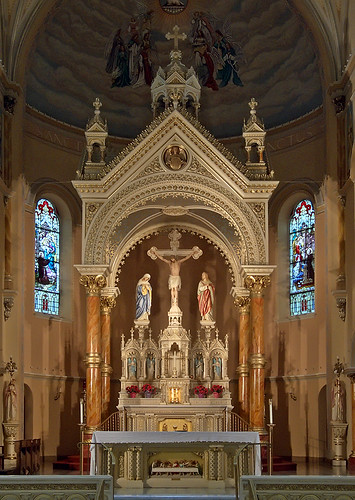
The long history of St. Anthony's begins in 1863 when the first Eucharist was celebrated by Fr. Servace Altmicks, O.F.M. in a house donated by Mr. Whitnell. From these humble beginnings the parish began to grow and the first church was built on the corner of Meramec Street and Compton Avenue. That first church was consecrated by Bishop Hogan in 1869.It ought to be noted that although this is a fairly small parish, this church has many friends and benefactors, including those who formerly lived in the neighborhood.
The value of education of the children of the parish took a big step forward with the building of the first parish school in the year 1870. In 1883, the Sisters of St. Joseph of Carondelet joined the parish and have served it faithfully ever since through their teaching ministry.
As the parish grew and prospered, a new church was begun in 1908 and was completed in 1910. Archbishop Glennon celebrated the first Mass there. This is our present church building used by St. Anthony's community.
There are currently about 480 households registered in the parish.
Archbishop Raymond L. Burke will ordain nine men to the priesthood for the Archdiocese of St. Louis at 10 a.m. Saturday, May 24, at the Cathedral Basilica of St. Louis, Lindell Boulevard and Newstead Avenue in the Central West End.First Masses:
The Sacrament of Holy Orders will be conferred after the reading of the Gospel of the Mass. An announcement of the new priests’ assignments will be in an upcoming issue of the Review.
The soon-to-be-ordained priests will be Fathers Matthew Barnard, Patrick Driscoll, Brian Hecktor, Michael Houser, Eric Kunz, Edward Nemeth, Kevin Schroeder, James Theby and Noah Waldman.
All have earned master of divinity degrees and master of arts in theology degrees from Kenrick-Glennon Seminary. For the past year, all have served as transitional deacons, which carries the title "Rev. Mr."
This is the largest number of men to be ordained priests for the Archdiocese of St. Louis since nine men were ordained in 1987. In addition, another five Kenrick-Glennon seminarians are being ordained in coming weeks for other dioceses.
[Rev. Mr. Matthew Barnard] will celebrate a Mass of Thanksgiving at 2 p.m. Sunday, May 25, at Little Flower Parish, 1264 Arch Terrace in Richmond Heights. Concelebrants will include Msgr. John Leykam and Fathers Lawrence Herzog, Theodore Rothrock and Christopher Weldon. Father Rothrock will be the homilist. A reception will be held following the Mass at Little Flower School.
[Rev. Mr. Patrick Driscoll] will celebrate a Mass of Thanksgiving at 3 p.m. Sunday, May 25, at the Shrine of St. Joseph, 11th and Biddle streets in Downtown St. Louis. Concelebrants will include Fathers William Pegnam, Robert McDermott and Thomas McDermott, OP. Father Thomas McDermott will be the homilist. A reception will follow the Mass.
[Rev. Mr. Brian Hecktor] will celebrate a Mass of Thanksgiving at 2 p.m. Sunday, May 25, at St. Ignatius Loyola Church, 701 Mill Road in Concord Hill. The homilist will be Msgr. Patrick Hambrough. A reception will be held in the parish hall following Mass.
[Rev. Mr. Michael Houser] will celebrate two Masses of Thanksgiving on Sunday, May 25. He will celebrate Mass (in the extraordinary, or Tridentine Latin, form) at 10 a.m. at St. Francis de Sales Oratory, 2653 Ohio Ave. in South St. Louis, and at 3 p.m. at Ascension Church, 230 Santa Maria Drive in Chesterfield. The homilist at the 10 a.m. Mass will be Father Michael Monshau, OP, and the homilist at the 3 p.m. Mass will be Msgr. Joseph Pins. A reception will be held at 4:30 p.m. at Ascension Parish.
[Rev. Mr. Eric Kunz] will celebrate a Mass of Thanksgiving at 3 p.m. Sunday, May 25, at Immaculate Conception Church, 100 N. Washington Ave. in Union. Father Joseph Havrilka will be the homilist. A reception will be held at the parish following Mass.
[Rev. Mr. Edward Nemeth] will celebrate a Mass of Thanksgiving at 11 a.m. Sunday, May 25, at St. Gabriel the Archangel Church, 6303 Nottingham Ave. in St. Louis Hills. Father C. Eugene Morris will be the homilist. A reception will be held in the school gym after Mass.
[Rev. Mr. Kevin Schroeder] will celebrate a Mass of Thanksgiving at 2 p.m. Sunday, May 25, at St. Cletus Church, 2705 Zumbehl Road in St. Charles. Father Brian Fischer will be the homilist. A reception will be held at the parish after Mass.
[Rev. Mr. James Theby] will celebrate a Mass of Thanksgiving at 2 p.m. Sunday, May 25, at Incarnate Word Parish, 13426 Olive Blvd. in Chesterfield. Father Edward Rice will be the homilist. A reception will be held at the parish following Mass.
[Rev. Mr. Noah Waldman] will celebrate a Mass of Thanksgiving at 1:30 p.m. Sunday, May 25, at St. Clement of Rome Church, 1510 Bopp Road in Des Peres. Concelebrants will include Msgr. James Pieper, Msgr. Robert McCarthy, Father John Johnson and Father John Hunthausen, SJ. Father Johnson will be the homilist. A reception will be held from 3 to 4 p.m. in the church hall.
